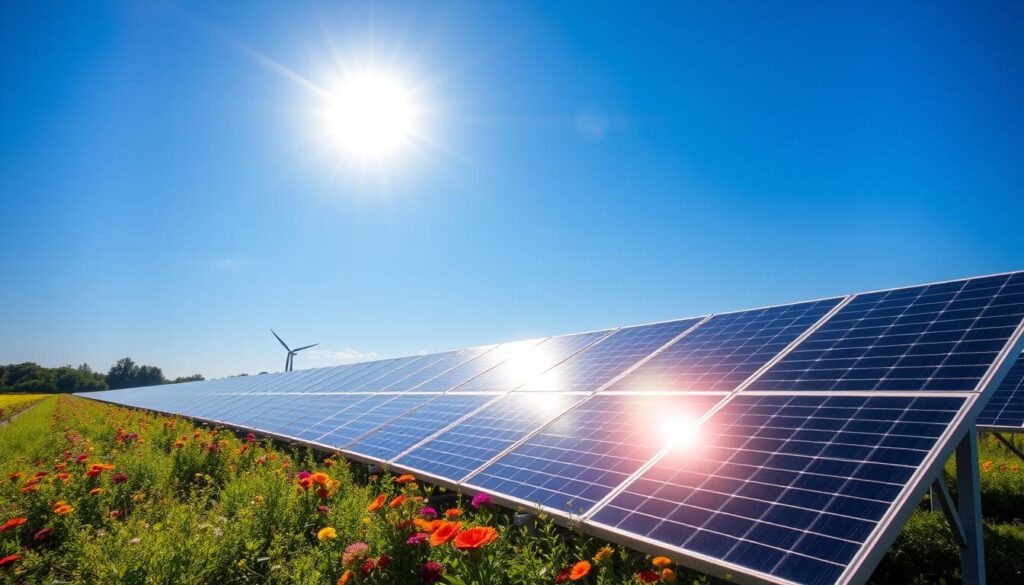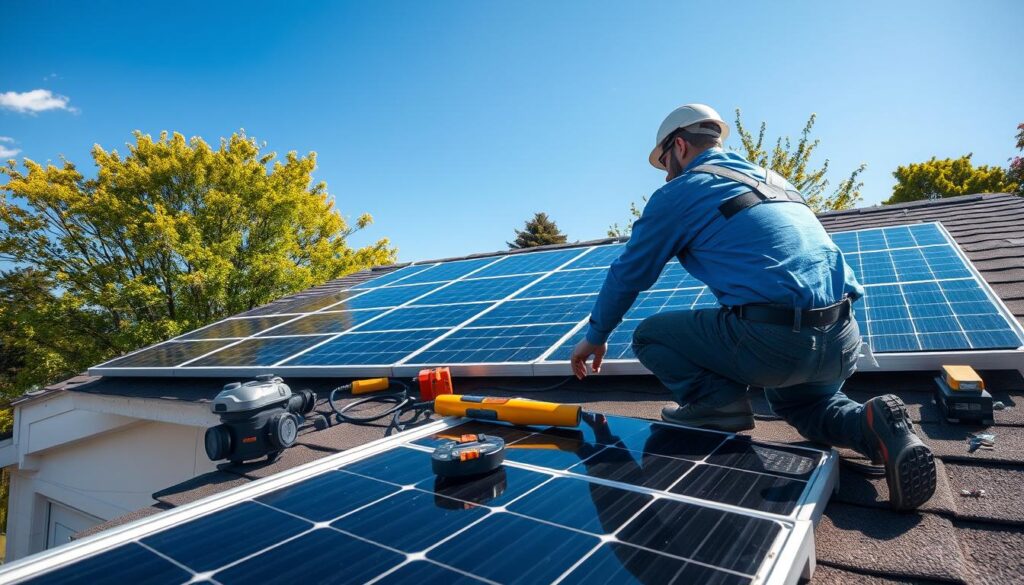Unlock the power of the sun and start a journey towards a greener future.
This guide will take you into the exciting world of solar energy. It’s a fast-growing and promising source of renewable power. You’ll learn about the basics of using the sun’s energy, the various solar technologies, and the benefits of solar power.
You’ll also find out how to install a solar panel system. By the end of this guide, you’ll know how solar energy helps make our world more sustainable. You’ll be ready to make informed choices and contribute to a renewable future.

Key Takeaways
- Understand the basics of solar energy and how it works
- Explore the different types of solar energy technologies
- Discover the environmental and economic benefits of solar power
- Learn about the process of installing solar panels
- Gain insights into the future of solar energy and its role in sustainable living
What is Solar Energy?
Solar energy comes from the sun’s rays and can be turned into electricity or heat. It’s a clean, renewable energy that’s getting more attention as a better choice than fossil fuels.
Harnessing the Power of the Sun
The sun’s energy is captured in two main ways: photovoltaic (PV) systems and solar thermal technology. PV systems make electricity from sunlight. Solar thermal technology uses the sun’s heat for power or to warm and cool buildings.
Types of Solar Energy Technologies
There are many solar energy technologies, each with its own use. Here are a few:
- Rooftop solar panels: These photovoltaic panels are on roofs to make electricity.
- Solar thermal collectors: They use sun heat to warm water or heat buildings.
- Concentrated solar power (CSP) plants: These big solar thermal technology systems use mirrors to make electricity.
- Solar-powered water pumps and irrigation systems: These renewable energy sources help in areas without electricity.
As we focus more on energy efficiency, solar energy’s importance grows. It’s a clean, sustainable way to meet our energy needs.
Understanding Solar Energy: A Beginner’s Guide to Renewable Power
The world is moving towards renewable energy, and solar power is leading the way. Understanding solar energy is key for those who want to live sustainably and help our planet. This guide will dive into the science of solar power, its role in the world’s energy, and its benefits for the environment and economy.
Solar energy turns sunlight into electricity. This happens through the photovoltaic effect, where photovoltaic cells catch sun rays and create electricity. These cells, in panels, power homes and big plants.
Solar energy is versatile. It’s a renewable source that cuts down on fossil fuels. It also powers heating and electricity systems. As technology advances, solar power’s future looks even brighter, promising a greener world.
| Solar Energy Technology | Description |
|---|---|
| Photovoltaic (PV) Cells | These semiconductor devices convert sunlight directly into electricity through the photovoltaic effect. |
| Concentrated Solar Power (CSP) | CSP systems use mirrors or lenses to concentrate sunlight, which then heats a fluid that drives a turbine to generate electricity. |
| Solar Thermal Collectors | These systems harness the sun’s heat to warm water or provide space heating, without generating electricity. |
As we seek sustainable living and consider our energy’s environmental impact, solar power’s role is crucial. It lets us use the sun’s energy, cutting carbon emissions and costs. This path leads to a brighter, greener future.
Benefits of Solar Energy
Using solar energy has many advantages for both homes and businesses. It helps us use the sun’s power to make our future greener and more affordable. This way, we can enjoy the benefits of a sustainable lifestyle.
Environmental Advantages
Solar energy is great for the planet. It makes much less pollution than old power sources. This means it helps fight climate change by reducing harmful emissions.
It’s a clean, endless resource that doesn’t harm our air, water, or land. This makes it a top choice for those who care about the environment.
Economic Incentives
Solar energy also saves money. Governments give out tax breaks and rebates to help people use solar power. These deals make solar energy cheaper to start with.
Also, solar panels can cut down your electricity bills over time. This is especially true in places where electricity costs a lot. It’s a smart way to save money.
| Benefit | Description |
|---|---|
| Environmental Impact | Solar energy generation produces significantly fewer greenhouse gas emissions compared to traditional fossil fuel-based power sources, helping to reduce the overall carbon footprint and mitigate the effects of climate change. |
| Government Incentives | Many governments offer various tax credits, rebates, and other financial incentives to encourage the adoption of solar technology, helping to offset the initial investment costs. |
| Cost Savings | Harnessing solar energy can lead to long-term cost savings on electricity bills, as the energy generated by solar panels is free and renewable, providing a significant financial advantage. |

By choosing solar energy, we help make our planet healthier and more affordable. This choice supports a greener future and helps us move towards cleaner energy sources.
Solar Panel Installation
Switching to solar power is a big step towards living sustainably. It involves installing solar panels on your home or building. This process might seem hard, but with the right help, it’s easy and rewarding. Let’s look at the main steps in installing solar panels and how government incentives can help make it more affordable.
Site Assessment and System Design
The first step is a detailed site assessment. Solar experts will check your property and design a solar system just for you. They consider sunlight and your energy use to make sure it works well and lasts long.
Permits and Paperwork
Getting the right permits and paperwork is key. Your solar provider will help you with local and state rules. This ensures your system is safe and legal.
Leveraging Government Incentives
Government incentives and rebates make solar energy more affordable. These programs can cut down the cost of installing solar panels. By using these incentives, you can start living more sustainably and get the most from your solar investment.
| Incentive | Description | Potential Savings |
|---|---|---|
| Federal Tax Credit | A tax credit that covers a percentage of the total cost of a solar energy system | Up to 26% of the system cost |
| State Rebates | Incentives offered by individual states to encourage solar panel adoption | Varies by state, but can range from $0.50 to $1.50 per watt of installed capacity |
| Net Metering | A policy that allows homeowners to receive credit for the excess energy their solar panels generate and feed back into the grid | Reduced electricity bills and potential for earning credits |
Understanding solar installation and using government incentives can make going solar easier and cheaper. Start using the sun’s power and move towards a greener, more efficient future.

Solar Thermal Technology
Photovoltaic solar panels are well-known for renewable energy. But, solar thermal technology is also key for sustainable power. It uses the sun’s heat for hot water, space heating, and industrial processes. This makes it a great addition to solar PV systems.
How Solar Thermal Systems Work
Solar thermal systems capture the sun’s energy and turn it into heat. They have a solar collector, a heat transfer fluid, and a storage tank or heat exchanger. The collector, like flat panels or tubes, absorbs the sun’s heat.
This heat is then moved to the fluid, like water or a glycol solution. The fluid is circulated to the use point or a storage tank. This stored heat is good for hot water, heating spaces, or industrial needs like drying.
| Key Components of Solar Thermal Systems | Function |
|---|---|
| Solar Collector | Absorbs the sun’s radiant energy and converts it into thermal energy |
| Heat Transfer Fluid | Carries the thermal energy from the solar collector to the point of use or storage |
| Storage Tank | Stores the collected thermal energy for later use |
| Heat Exchanger | Transfers the thermal energy from the heat transfer fluid to the desired application |
Solar thermal technology uses the sun’s heat efficiently and sustainably. It fits into many uses, from home hot water to big industrial needs. As we move towards a greener future, this tech will be crucial for our energy needs.
Photovoltaic Panels
Photovoltaic (PV) panels turn sunlight into electricity, a key part of renewable energy. These solar panels use the sun’s energy to make clean, sustainable power. This power can run our homes, businesses, and communities.
Maximizing Solar Energy Efficiency
To get the most from your solar PV system, consider a few things. Make sure your panels face the right direction and tilt at the right angle. This helps them catch more sun and work better.
Also, keep your panels clean. Dust and debris can block sunlight and reduce their efficiency. Regular cleaning helps them work at their best.
Choosing the right PV panels is also important. Newer panels use better materials, like monocrystalline and polycrystalline silicon. These materials help turn sunlight into electricity more efficiently than older panels.
| Photovoltaic Panel Type | Efficiency Range |
|---|---|
| Monocrystalline Silicon | 15-22% |
| Polycrystalline Silicon | 13-17% |
| Thin-Film | 10-15% |
By understanding PV panel technology and following best practices, you can make your solar system work better. This helps us move towards a greener, more sustainable future.
“Photovoltaic panels are the key to unlocking the boundless potential of solar energy, paving the way for a greener, more sustainable tomorrow.”
Conclusion
Solar energy is a promising and fast-growing renewable energy source. It can help us live more sustainably. Learning about solar technology and its benefits can guide you in using the sun’s power. This way, you can help make our future greener.
The future of solar power looks bright. It offers many advantages, like cutting down on carbon emissions and saving money. Whether you’re a homeowner, business owner, or just curious, starting with solar energy is a big step towards a better future.
Choosing solar technology means getting a reliable and affordable energy source. It also helps tackle big environmental issues. As we all move towards renewable energy sources, your choice of solar energy can make a big difference. It can inspire others to do the same.
FAQ
What is solar energy?
Solar energy comes from the sun’s rays. It can be turned into electricity or heat. It’s a fast-growing, promising clean energy source.
How does solar energy work?
Solar energy works through two main ways. Photovoltaic (PV) systems turn sunlight into electricity. Solar thermal systems use sun heat for power or to warm and cool buildings.
What are the benefits of using solar energy?
Solar energy has many benefits. It’s good for the environment, cuts down on carbon emissions, and can save money. Tax credits and rebates make it more affordable for homes and businesses.
How do I install solar panels?
Installing solar panels involves a few steps. First, assess your site and design your system. Then, get permits and use government incentives. A pro can help you through it all.
What is solar thermal technology?
Solar thermal tech uses sun heat for hot water, space heating, and industrial processes. It’s a great addition to solar PV systems.
How can I maximize the efficiency of my solar PV system?
To boost your solar PV system’s efficiency, orient panels right, use efficient inverters, and keep panels clean. Regular maintenance is key.
What is the future of solar power?
Solar power’s future looks bright. It will become more important in the world’s energy mix. Tech will improve, costs will drop, and more people will choose sustainable living.










1 thought on “Solar Energy: A Beginner’s Guide to Renewable Power”
Comments are closed.